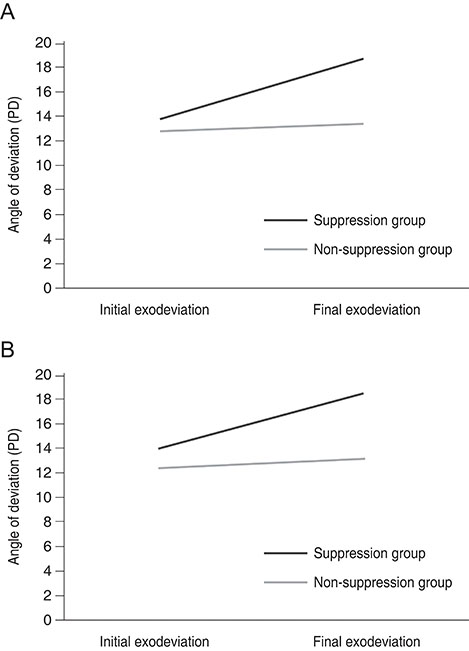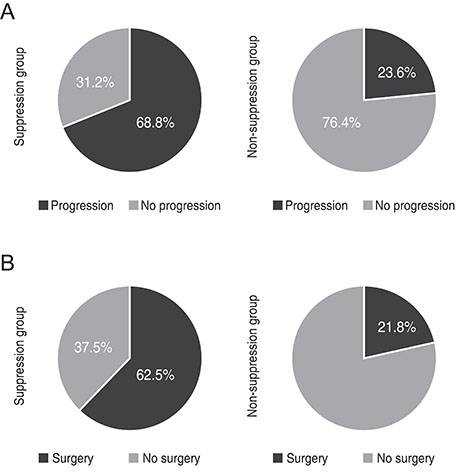Korean J Ophthalmol.
2019 Oct;33(5):446-450. 10.3341/kjo.2019.0054.
Distance Suppression as a Predictive Factor in Progression of Intermittent Exotropia
- Affiliations
-
- 1Department of Ophthalmology, Korea University College of Medicine, Seoul, Korea. ansaneye@korea.ac.kr
- KMID: 2459526
- DOI: http://doi.org/10.3341/kjo.2019.0054
Abstract
- PURPOSE
To address the natural course of intermittent exotropia with small exodeviations (less than 20 prism diopters [PD]) according to the status of suppression, and to evaluate whether suppression testing at the initial visit can assist in predicting the progression of intermittent exotropia.
METHODS
Clinical records of patients at the Korea University Anam Hospital, Seoul, Korea diagnosed between January 2014 and December 2018 with basic-type intermittent exotropia and initial distance deviations of less than 20 PD, older than four years of age and a minimum of three follow-up visits within a 6-month span were retrospectively reviewed. The participants were divided into two groups, the suppression group and the non-suppression group, based on the Vectogram results at the initial visit. Clinical characteristics, rate of surgery, and rate of progression were compared between the two groups.
RESULTS
A total of 71 patients were included. Among them, 16 patients (22.5%) had visual suppression at the initial visit, while 55 patients (77.5%) had no suppression. At the initial visit, the mean distant angle of deviation was 13.7 ± 3.2 PD (range, 4 to 18 PD) in the suppression group and 12.7 ± 3.4 PD (range, 10 to 18 PD) in the non-suppression group. Ten patients (62.5%) underwent surgery in the suppression group and 12 patients (21.8%) underwent surgery in the non-suppression group (p < 0.01). Eleven patients (68.8%) in the suppression group and 13 (23.6%) in the non-suppression group developed progression (p < 0.01).
CONCLUSIONS
Suppression testing was important to predict the progression of intermittent exotropia, in patients with exodeviation angles less than 20 PD at the initial visit.
Keyword
Figure
Reference
-
1. Hiles DA, Davies GT, Costenbader FD. Long-term observations on unoperated intermittent exotropia. Arch Ophthalmol. 1968; 80:436–442.
Article2. Nusz KJ, Mohney BG, Diehl NN. The course of intermittent exotropia in a population-based cohort. Ophthalmology. 2006; 113:1154–1158.
Article3. Sanfilippo S, Clahane AC. The effectiveness of orthoptics alone in selected cases of exodeviation: the immediate results and several years later. Am Orthopt J. 1970; 20:104–117.
Article4. Kii T, Nakagawa T. Natural history of intermittent exotropia: statistical study of preoperative strabismic angle in different age groups. Nippon Ganka Gakkai Zasshi. 1992; 96:904–909.5. Mohney BG, Huffaker RK. Common forms of childhood exotropia. Ophthalmology. 2003; 110:2093–2096.
Article6. Romanchuk KG, Dotchin SA, Zurevinsky J. The natural history of surgically untreated intermittent exotropia-looking into the distant future. J AAPOS. 2006; 10:225–231.
Article7. Chia A, Seenyen L, Long QB. A retrospective review of 287 consecutive children in Singapore presenting with intermittent exotropia. J AAPOS. 2005; 9:257–263.
Article8. von Noorden GK. Clinical observations in cyclodeviations. Ophthalmology. 1979; 86:1451–1461.
Article9. Ohtsuki H, Hasebe S, Okano M, Furuse T. Comparison of surgical results of responders and non-responders to the prism adaptation test in intermittent exotropia. Acta Ophthalmol Scand. 1997; 75:528–531.
Article10. Von Noorden GK, Campos EC. Binocular vision and ocular motility: theory and management of strabismus. 6th ed. St. Louis: Mosby;2002. p. 359–368.11. Rosenbaum AL, Santiago AP. Clinical strabismus management: principles and surgical techniques. Philadelphia: Saunders;1999. p. 165–166.12. Kim SH, Ahn KJ, Cho YA. Sensory testing for binocular suppression in accommodative esotropes. J Korean Ophthalmol Soc. 1997; 38:762–768.13. Jampolsky A. Differential diagnostic characteristics of intermittent exotropia and true exophoria. Am Orthopt J. 1954; 4:48–55.
Article14. Jampolsky A. Characteristics of suppression in strabismus. AMA Arch Ophthalmol. 1955; 54:683–696.
Article15. Mohney BG, Holmes JM. An office-based scale for assessing control in intermittent exotropia. Strabismus. 2006; 14:147–150.
Article
- Full Text Links
- Actions
-
Cited
- CITED
-
- Close
- Share
- Similar articles
-
- The Photophobia Incidence, Stereopsis and Suppression in Intermittent Exotropia
- The Influence of Suppression on Axial Length Progression in Intermittent Exotropia
- Distance Stereoacuity in Children with Intermittent Exotropia Using B-VAT II Video Acuity Tester
- Surgieal Result of Intermittent Exotropia: Comparison of Sensory Anomaly
- The Changes of Exodeviation according to Distance and after Patching of Deviated Eye for 1 Hour in Intermittent Exotropia



